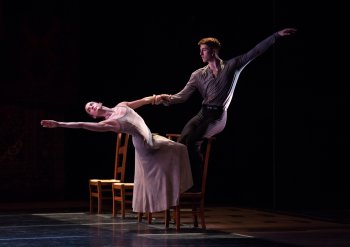Julliard Dances Repertory 2016
A totally successful evening of stylishly danced masterpieces.

Joshua Guillemot-Rodgerson and Mikaela Kelly in a scene from Paul Taylor’s “Roses” (Photo credit: Rosalie O’Connor)
[avatar user=”Joel Benjamin” size=”96″ align=”left” ] Joel Benjamin, Critic[/avatar]The Juilliard Dance Division presented a totally successful, totally exciting evening of three masterpieces of modern choreography, including—a rare event—a ballet on point, Jerome Robbins’ “Moves.” All three works presented stylistic challenges that were met head on.
“Roses,” Paul Taylor’s athletic, but lyrical musing on physical love is in two parts, the first for five couples to Wagner’s lush Siegfried Idyll and the second featuring a single leading couple to Heinrich Baermann’s Adagio for Clarinet and Strings, both brilliantly played by the Juilliard Orchestra under the direction of George Manahan, as was the final work on the program, Stravinsky’s complex Symphony of Psalms.
As the quiet, meditative Wagner score begins, the five couples—women in long dark sleeveless dresses, the men in black sleeveless tops and black pants designed by William Ivey Long—are lounging in each others’ arms. They begin to move slowly, rising and leaning on each other leading to soft, curvaceous lifts and finally to some courageously acrobatic leaps through upraised arms and over upraised legs. The mounting passion then settles back down as the second part, led by a more quietly amorous couple—Mikaela Kelly and Joshua Guillermot-Rodgerson—dressed all in white, begins. They appear to be further along in their relationship. Even though they also do their own acrobatic lifts and jumps, they have a tenser physical relationship. By the end, they have quietly joined the others after melding in a series of breathless, sensuous confrontations. Jennifer Tipton’s original richly atmospheric lighting was re-created by Clifton Taylor. The fine clarinet soloist for the Baermann’s piece was Shen Liu.

Mark Sampson and My’Kal Stomile in a scene from Jerome Robbins’ “Moves” (Photo credit: Rosalie O’Connor)
“Moves” by Jerome Robbins is a dance for ten ballet dancers, performed without music. The dancers, dressed in everyday practice outfits, at first move in formal straight lines before breaking into pockets of sculptural groupings or easygoing duets. Robbins’ genius is making us realize that—literally—every movement does have a meaning of its own. Somehow Robbins, using basic classical ballet vocabulary, causes relationships to materialize right in front of us: lovers, eager friends, strangers passing each other anonymously and, in one particularly poignant moment, the end of a relationship. A young man and woman face each other. She rises on point, her hands on his shoulders as they look into each others’ eyes. He turns away from her, her hands still on his shoulders, then walks calmly away, leaving her, arms extended and bereft. That’s the magic of Robbins. These dancers caught all the subtlety and pathos while also showing off strong ballet technique, helped enormously by Kathleen Tracey’s re-creation of Ms. Tipton’s stark lighting plan.

Zoë McNeil and Riley O’Flynn in a scene from Jiri Kylián’s “Symphony of Psalms” (Photo credit: Rosalie O’Connor)
“Symphony of Psalms” is Jiri Kylián’s deeply felt reaction to Stravinsky’s monumental score. In front of a wall constructed of hanging Oriental rugs, the sixteen dancers, dressed in Joop Stokvis’ dark, everyman outfits, are formally arrayed along the sides of the stage on chairs at the beginning. Kylián’s purposely austere choreography pits lines of dancers against each other, weaving in and out, depositing single dancers who perform anguished solos before rejoining the ensemble. Even though the mood is dark, there is an element of celebration, helped enormously by the singing of the Venture(NY) chorus under the direction of Kent Tritle who worked seamlessly with maestro Manahan to bring this sumptuous score to life. This is a spiritual ritual given inspirational life by a combination of choreography, lighting, costumes, music and superb dancing by these young Juilliard students. Somehow Mr. Kylián’s seemingly simple manipulation of groups of dancers added up to a pageant of religious passion made manifest. The austere, angular lighting was by Kees Tjebbes.
This was a particularly satisfying showing by the Juilliard Dances Repertory. It’s good to know that there is hope for the future of dance represented by these students, all of whom displayed fine technique and understanding of the different works. Also, the respect and care paid to these three choreographic geniuses makes it clear that they won’t soon be forgotten.
Juilliard Dances Repertory 2016 (March 23-26, 2016)
Juilliard’s Peter Jay Sharp Theater, 155 West 65th Street, in Manhattan
For tickets, call 212-799-5000 or visit http://www.events@juilliard.edu
Running time: two hours and 15 minutes including two intermissions
A totally successful evening of stylishly danced masterpieces.






Leave a comment